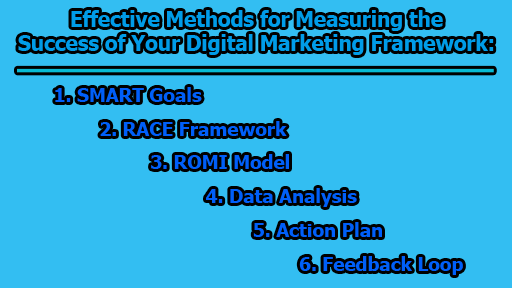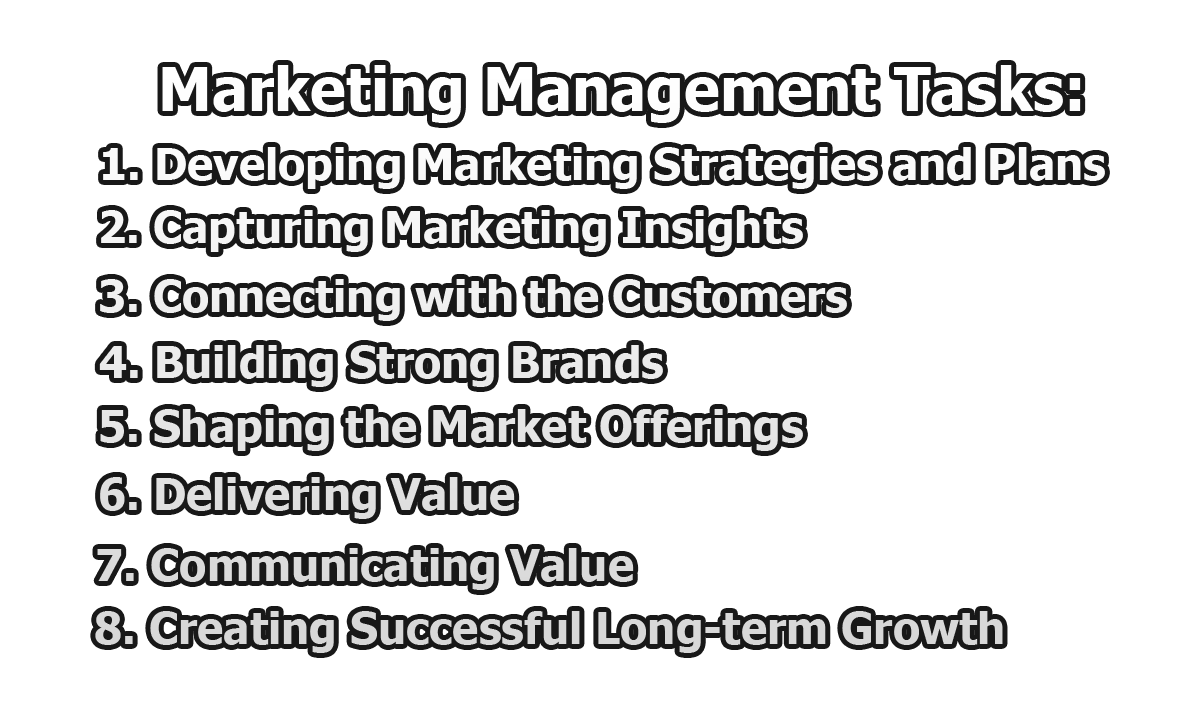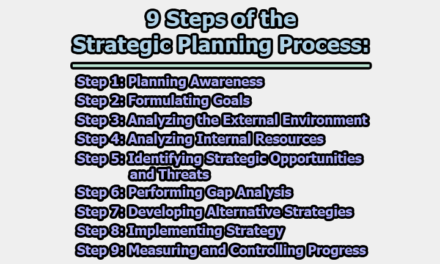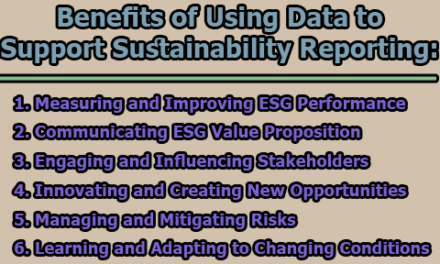Effective Methods for Measuring the Success of Your Digital Marketing Framework:
In today’s digital age, businesses rely on digital marketing frameworks to guide their online campaigns and connect with their target audience. These frameworks provide a structured approach to planning, executing, and measuring digital marketing efforts, but it’s essential to determine if they are effective. Measuring the success of a digital marketing framework is crucial to ensuring that your efforts yield the desired results. In this article, we will explore some of the most effective methods for measuring the success of your digital marketing framework using the SMART, RACE, and ROMI models.
1. SMART Goals: Setting SMART goals is a fundamental and crucial aspect of any digital marketing framework. SMART is an acronym that stands for Specific, Measurable, Achievable, Relevant, and Time-bound. These criteria help in crafting well-defined and attainable objectives for your digital marketing efforts. Let’s delve into each component:
- Specific: The “S” in SMART signifies that your goal should be crystal clear and precisely defined. It should answer the “what,” “who,” “where,” and “why” of your goal. In the context of digital marketing, being specific means clearly outlining the desired outcome. For instance, instead of a vague goal like “improve website performance,” a specific goal would be “increase organic traffic to our website.”
- Measurable: The “M” emphasizes the importance of quantifying your goals. You should be able to track and measure your progress. In digital marketing, measurable goals are essential because they provide a basis for monitoring performance and assessing whether you are moving in the right direction. For instance, “increase organic traffic by 25%” is a measurable goal because you can track the percentage increase over time using analytics tools.
- Achievable: The “A” reminds us that goals should be realistic and attainable. While it’s good to aim high, setting unattainable goals can lead to frustration and demotivation. In digital marketing, it’s crucial to set goals that consider the available resources, capabilities, and market conditions. For example, setting a goal to “increase organic traffic by 500% in a month” may not be realistic unless you have substantial resources and a very niche audience.
- Relevant: The “R” highlights the importance of setting goals that are relevant to your business objectives and the broader digital marketing strategy. Goals should align with your company’s mission and support its overall success. For instance, if your primary business goal is to boost e-commerce sales, a relevant digital marketing goal might be “increase website conversions by 15%.”
- Time-bound: The “T” emphasizes the need to set a specific timeframe for achieving your goals. This adds a sense of urgency and helps in planning and tracking progress effectively. In digital marketing, time-bound goals ensure that you stay on track and make continuous improvements. “Increase organic traffic to our website by 25% in the next six months” is a time-bound goal because it has a clear timeframe for achieving the 25% increase.
By adhering to the SMART criteria, you create a framework for setting objectives that are not only well-defined but also practical and aligned with your overall digital marketing strategy. These goals provide a roadmap for your marketing efforts, making it easier to track progress and measure the effectiveness of your digital marketing initiatives. SMART goals serve as a foundation for success, guiding your team towards achieving tangible and meaningful results in the digital landscape.
2. RACE Framework: The RACE framework is a customer-centric model that plays a pivotal role in aligning your digital marketing strategy with the various stages of the customer journey. RACE is an acronym that stands for Reach, Act, Convert, and Engage. Let’s break down the RACE framework and understand how it helps assess the effectiveness of your digital marketing framework at different points in the customer’s interaction with your brand:
- Reach: The “Reach” stage is where you aim to capture the attention of your target audience. At this point, your primary focus is on creating brand awareness and driving potential customers to your digital assets. Key performance indicators (KPIs) relevant to the “Reach” stage should correspond with your SMART goals. For instance, if your SMART goal is to “increase organic traffic to our website by 25% in the next six months,” KPIs for this stage might include website traffic, bounce rates, referral sources, and social media reach. Tools such as Google Analytics can be employed to measure these KPIs. By monitoring these metrics, you gain insights into how effectively you’re attracting and engaging your target audience.
- Act: In the “Act” stage, you want your audience to take specific actions, such as signing up for a newsletter, downloading a resource, or engaging with your content. KPIs for this stage often include click-through rates, form submissions, and content engagement metrics. By tracking these KPIs, you can gauge how well your digital marketing efforts are compelling your audience to interact with your brand and its offerings. This stage is critical for moving potential customers further down the sales funnel.
- Convert: “Convert” is the stage where your audience transitions from being leads to customers. The primary KPIs in this stage often revolve around conversion rates, sales, and revenue generated from your digital marketing efforts. Tracking these metrics helps you assess the effectiveness of your digital marketing strategies in driving conversions and ultimately revenue for your business. Conversions can take various forms, from making a purchase to requesting a quote or signing up for a premium service.
- Engage: The “Engage” stage focuses on maintaining and deepening the relationship with your existing customers. KPIs here may include customer retention rates, repeat purchases, and customer satisfaction scores. Engaging existing customers is crucial for building brand loyalty and encouraging repeat business. It’s also more cost-effective than acquiring new customers, making it a valuable part of your digital marketing strategy.
The RACE framework’s strength lies in its ability to guide your digital marketing activities according to the customer journey, ensuring that your efforts are well-coordinated and relevant to each stage. By identifying and measuring the right KPIs for each stage, you can gain valuable insights into your digital marketing framework’s performance. This information enables you to refine your strategies, improve the customer experience, and, ultimately, achieve your SMART goals. As the digital landscape continues to evolve, the RACE framework serves as a valuable tool for staying in tune with your audience and delivering results that matter.
3. ROMI Model: The ROMI (Return on Marketing Investment) model is a powerful tool that plays a critical role in assessing the financial efficiency and profitability of your digital marketing campaigns. This model enables you to make data-driven decisions regarding your resource allocation and the overall effectiveness of your marketing initiatives. Let’s take a closer look at how the ROMI model works and why it is so valuable:
- ROMI Formula: ROMI is calculated using a straightforward formula: (Revenue – Marketing Cost) / Marketing Cost. In essence, it measures the return on investment (ROI) specifically related to your marketing efforts. The result of this calculation provides a clear indication of whether your marketing campaign generated a positive or negative financial return.
- Example Calculation: To illustrate the concept, let’s consider an example. Suppose you spent $10,000 on a digital marketing campaign, and this campaign generated $50,000 in revenue. Using the ROMI formula, you would calculate it as follows: ($50,000 – $10,000) / $10,000 = 4. In this scenario, a ROMI of 4 indicates that for every dollar spent on marketing, you earned $4 in revenue. A ROMI greater than 1 suggests that your marketing efforts are generating a positive return on investment.
- Interpreting ROMI: ROMI provides a clear and quantitative measure of the efficiency and profitability of your marketing campaigns. When your ROMI is greater than 1, it signifies that your marketing campaign generated more revenue than the cost incurred. This is a strong indicator of a successful campaign. Conversely, if your ROMI is less than 1, it implies that your marketing campaign did not generate enough revenue to cover the associated costs, and adjustments may be necessary.
- Resource Allocation: One of the key advantages of the ROMI model is its ability to inform resource allocation decisions. By analyzing the ROMI of different marketing campaigns or channels, you can identify which areas are delivering the best returns. This insight empowers you to allocate more resources to the most effective campaigns and potentially adjust or discontinue less profitable ones.
- Continuous Improvement: ROMI provides a basis for continuous improvement in your digital marketing efforts. By tracking and comparing the ROMI of various campaigns over time, you can identify trends and make data-driven decisions to optimize your marketing strategies. This may include adjusting your budget, reallocating resources, or fine-tuning your targeting to maximize profitability.
- ROI vs. ROMI: It’s important to note that while ROMI focuses on marketing-specific ROI, it is just one facet of overall ROI. The broader ROI includes all investments and expenses related to your business. ROMI is a valuable subset of ROI that specifically addresses the effectiveness of your marketing activities.
The ROMI model is an invaluable tool for assessing the financial impact of your digital marketing framework. It provides a clear, quantifiable measure of the return on investment from your marketing campaigns. By calculating and analyzing ROMI, you gain insights that not only indicate the success of your marketing efforts but also guide strategic decisions regarding resource allocation and campaign optimization. This data-driven approach is essential for achieving maximum efficiency and profitability in the digital marketing landscape.
4. Data Analysis: Data analysis plays a pivotal role in measuring the effectiveness of your digital marketing framework. It involves examining the information collected from your SMART goals, RACE framework, and ROMI model. Data analysis reveals patterns, trends, and valuable insights, as well as strengths, weaknesses, opportunities, and threats within your digital marketing strategy. Utilizing various tools and techniques such as dashboards, reports, charts, graphs, and statistics, you can gain a deeper understanding of your performance and identify areas for improvement.
5. Action Plan: Following data analysis, it is essential to create an action plan based on your findings. An action plan translates your insights into actionable steps to enhance your digital marketing results. It aids in setting objectives, strategies, tactics, timelines, budgets, and assigning roles. This structured approach ensures that you address the identified weaknesses and capitalize on the strengths. It also helps in resource allocation and prioritizing tasks, ultimately strengthening your digital marketing framework.
6. Feedback Loop: Establishing a feedback loop is the final step in measuring your digital marketing framework’s success. This cyclical process involves gathering feedback from customers, stakeholders, and data sources, analyzing this feedback, and implementing changes based on it. The feedback loop ensures that your digital marketing framework remains aligned with your goals, responsive to your audience, and adaptable to changes in the environment. Continuously monitoring and adjusting your framework helps you stay competitive in the dynamic digital landscape.
In conclusion, measuring the effectiveness of your digital marketing framework is essential for achieving your online marketing objectives. By following these steps – setting SMART goals, using the RACE framework, employing the ROMI model, conducting data analysis, creating an action plan, and establishing a feedback loop – you can ensure that your digital marketing strategy is on track and continually evolving to meet your business goals. In a world where digital marketing is ever-evolving, the ability to measure your framework’s success is critical for long-term success.

Library Lecturer at Nurul Amin Degree College










